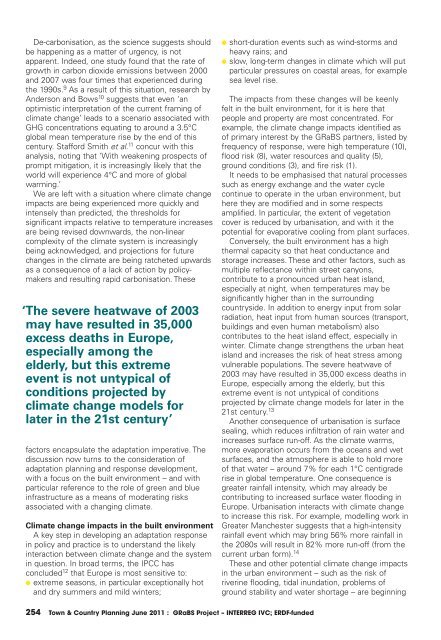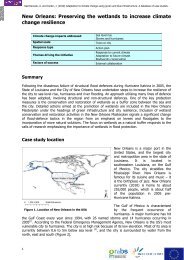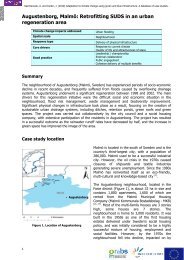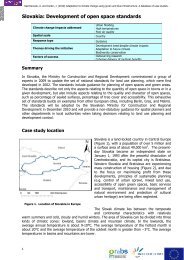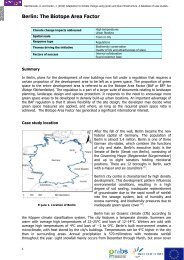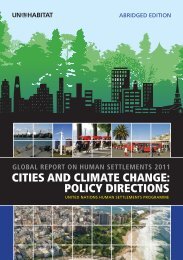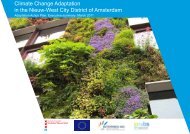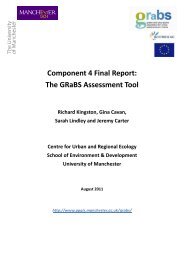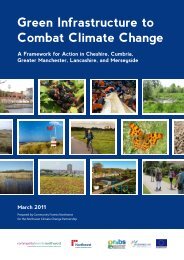Download - GRaBS
Download - GRaBS
Download - GRaBS
You also want an ePaper? Increase the reach of your titles
YUMPU automatically turns print PDFs into web optimized ePapers that Google loves.
De-carbonisation, as the science suggests should<br />
be happening as a matter of urgency, is not<br />
apparent. Indeed, one study found that the rate of<br />
growth in carbon dioxide emissions between 2000<br />
and 2007 was four times that experienced during<br />
the 1990s. 9 As a result of this situation, research by<br />
Anderson and Bows 10 suggests that even ‘an<br />
optimistic interpretation of the current framing of<br />
climate change’ leads to a scenario associated with<br />
GHG concentrations equating to around a 3.5°C<br />
global mean temperature rise by the end of this<br />
century. Stafford Smith et al. 11 concur with this<br />
analysis, noting that ‘With weakening prospects of<br />
prompt mitigation, it is increasingly likely that the<br />
world will experience 4°C and more of global<br />
warming.’<br />
We are left with a situation where climate change<br />
impacts are being experienced more quickly and<br />
intensely than predicted, the thresholds for<br />
significant impacts relative to temperature increases<br />
are being revised downwards, the non-linear<br />
complexity of the climate system is increasingly<br />
being acknowledged, and projections for future<br />
changes in the climate are being ratcheted upwards<br />
as a consequence of a lack of action by policymakers<br />
and resulting rapid carbonisation. These<br />
‘The severe heatwave of 2003<br />
may have resulted in 35,000<br />
excess deaths in Europe,<br />
especially among the<br />
elderly, but this extreme<br />
event is not untypical of<br />
conditions projected by<br />
climate change models for<br />
later in the 21st century’<br />
factors encapsulate the adaptation imperative. The<br />
discussion now turns to the consideration of<br />
adaptation planning and response development,<br />
with a focus on the built environment – and with<br />
particular reference to the role of green and blue<br />
infrastructure as a means of moderating risks<br />
associated with a changing climate.<br />
Climate change impacts in the built environment<br />
A key step in developing an adaptation response<br />
in policy and practice is to understand the likely<br />
interaction between climate change and the system<br />
in question. In broad terms, the IPCC has<br />
concluded 12 that Europe is most sensitive to:<br />
● extreme seasons, in particular exceptionally hot<br />
and dry summers and mild winters;<br />
● short-duration events such as wind-storms and<br />
heavy rains; and<br />
● slow, long-term changes in climate which will put<br />
particular pressures on coastal areas, for example<br />
sea level rise.<br />
The impacts from these changes will be keenly<br />
felt in the built environment, for it is here that<br />
people and property are most concentrated. For<br />
example, the climate change impacts identified as<br />
of primary interest by the <strong>GRaBS</strong> partners, listed by<br />
frequency of response, were high temperature (10),<br />
flood risk (8), water resources and quality (5),<br />
ground conditions (3), and fire risk (1).<br />
It needs to be emphasised that natural processes<br />
such as energy exchange and the water cycle<br />
continue to operate in the urban environment, but<br />
here they are modified and in some respects<br />
amplified. In particular, the extent of vegetation<br />
cover is reduced by urbanisation, and with it the<br />
potential for evaporative cooling from plant surfaces.<br />
Conversely, the built environment has a high<br />
thermal capacity so that heat conductance and<br />
storage increases. These and other factors, such as<br />
multiple reflectance within street canyons,<br />
contribute to a pronounced urban heat island,<br />
especially at night, when temperatures may be<br />
significantly higher than in the surrounding<br />
countryside. In addition to energy input from solar<br />
radiation, heat input from human sources (transport,<br />
buildings and even human metabolism) also<br />
contributes to the heat island effect, especially in<br />
winter. Climate change strengthens the urban heat<br />
island and increases the risk of heat stress among<br />
vulnerable populations. The severe heatwave of<br />
2003 may have resulted in 35,000 excess deaths in<br />
Europe, especially among the elderly, but this<br />
extreme event is not untypical of conditions<br />
projected by climate change models for later in the<br />
21st century. 13<br />
Another consequence of urbanisation is surface<br />
sealing, which reduces infiltration of rain water and<br />
increases surface run-off. As the climate warms,<br />
more evaporation occurs from the oceans and wet<br />
surfaces, and the atmosphere is able to hold more<br />
of that water – around 7% for each 1°C centigrade<br />
rise in global temperature. One consequence is<br />
greater rainfall intensity, which may already be<br />
contributing to increased surface water flooding in<br />
Europe. Urbanisation interacts with climate change<br />
to increase this risk. For example, modelling work in<br />
Greater Manchester suggests that a high-intensity<br />
rainfall event which may bring 56% more rainfall in<br />
the 2080s will result in 82% more run-off (from the<br />
current urban form). 14<br />
These and other potential climate change impacts<br />
in the urban environment – such as the risk of<br />
riverine flooding, tidal inundation, problems of<br />
ground stability and water shortage – are beginning<br />
254 Town & Country Planning June 2011 : <strong>GRaBS</strong> Project – INTERREG IVC; ERDF-funded


